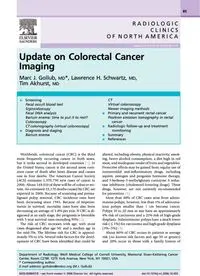
05 - Radiol Clin N Am 2007 - Update on Colorectal Cancer Imaging PDF
Preview 05 - Radiol Clin N Am 2007 - Update on Colorectal Cancer Imaging
Update on Colorectal Cancer Imaging Marc J. Gollub, MD*, Lawrence H. Schwartz, MD, Tim Akhurst, MD Worldwide, colorectal cancer (CRC) is the third most frequently occurring cancer in both sexes, but it ranks second in developed countries [1]. In the United States, cancer is the second most com- mon cause of death after heart disease and causes one in four deaths. The American Cancer Society (ACS) estimates 1,399,790 new cases of cancer in 2006. About 148,610 of these will be of colon or rec- tum. An estimated 55,170 deaths caused by CRC are expected in 2006. Because of screening and prema- lignant polyp removal, CRC incidence rates have been decreasing since 1985. Because of improve- ments in survival, mortality rates have also been decreasing an average of 1.8% per year. If CRC is di- agnosed at an early stage, the prognosis is favorable with 5-year survival rates exceeding 90% [2]. The risk of CRC increases with age, with most cases diagnosed after age 50, and a median age in the mid-70s. The lifetime risk for CRC is approxi- mately 5% to 6%. Several risks factors for the devel- opment of CRC have been identified that could be altered, including obesity, physical inactivity, smok- ing, heavy alcohol consumption, a diet high in red meat, and inadequate intake of fruits and vegetables. Protective effects may be gained from regular use of nonsteroidal anti-inflammatory drugs, including aspirin, estrogen and progestin hormone therapy, and 3-hydroxy-3-methylglutary coenzyme A reduc- tase inhibitors (cholesterol-lowering drugs). These drugs, however, are not currently recommended for prevention [3]. More than 80% of CRC cases arise from adeno- matous polyps; however, less than 1% of adenoma- tous polyps smaller than 1 cm become cancer. Polyps 10 to 20 mm in size have an approximately 4% risk of carcinoma and a 21% risk of high-grade dysplasia. Subcentimeter polyps have a much lower risk (%1%) for carcinoma and high-grade dysplasia (3%–5%) [4]. About 80% of CRC occurs in patients at average risk (no known risk factors and age 50 or greater) and 20% occur in those with a family history of R A D I O L O G I C C L I N I C S O F N O R T H A M E R I C A Radiol Clin N Am 45 (2007) 85–118 Department of Radiology, Weill Medical College of Cornell University, Memorial Sloan-Kettering Cancer Center, Room C276F, 1275 York Avenue, New York, NY 10021, USA * Corresponding author. E-mail address:
